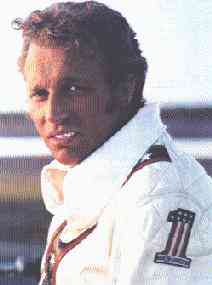Evel Knievel: America's Legendary Daredevil

There wasn't a person living in America during the 70s that wasn't well aware of the man in the star spangled helmet. His motorcycle stunts captured the attention of everyone, and influenced the behavior, perhaps unwisely, of many a young man... myself included. His confidence and persistence was a sterling example of what America was made of.
Best known for his ill-fated attempt to 'jump' the Snake River Canyon in 1974, he held several world records prior to that, mostly for jumping an ever-increasing number of cars, and later, buses. Taking off from the highest ski-style jump ramp ever used he thrilled the crowd of 35,000 by flying over 50 cars stacked in the center of the Los Angeles Colliseum on February 18, 1973.
His popularity spawned an episode in Happy Days in which Fonzie jumps 14 garbage cans to maintain his 'coolness'. Evel himself even starred in an episode of the highly-rated television show "The Bionic Woman". Then there was the cover of Sports Illustrated for September 1974.
Eager to emulate Evel, schoolboys took to creating bike ramps and broke countless bones (just as Evel did). Ideal Toy Company created various action figures and stunt toys and made over $300million.
In the winter of 1976 Evel was seriously injured during a nationally televised performance of an attempt to motorcycle jump a tank full of live sharks in the Chicago Ampitheater. For the first time a bystander was also injured when a cameraman was struck, eventually losing an eye. Knievel, who suffered a brain concussion and two broken arms, decided to retire from major performances but continued to do smaller exhibitions around the country with his son Robbie, establishing him as his successor.
Evel still holds the all time ABC's Wide world of Sports TV viewing audience record for his 52% of household share when his Kings Island performance was broadcast in 1975.
But if you look beyond the unflinchingly confident icon, there is the man, whose real name is Robert Craig Knievel. He was born in Butte, Montana in 1938. A natural athlete, he held records in ski jumping and formed a semiprofessional hockey league known as the Butte Bombers.
'Evel' worked in the copper mines as a diamond drill operator, then served in the Army. Upon his honorable discharge, he operated a hunting guide service back in Montana. In 1961 at the age of 23, he learned that the overpopulation of elk in Yellowstone National Park were being killed by park rangers. He travelled alone to Washington DC and convinced several congressmen and an aide to John F. Kennedy to relocate the animals rather than kill them. A practice which is still done to this day.
For a short period in 1962, he took a job as a salesman for the Combined Insurance Company of America. Although it might seem an odd fit for him, he set a company record by selling 271 polices in one week. Later, he went into motorcycle sales and was very successful with his sales pitch of offering a $100 discount to anyone who could beat him at arm wrestling.
In a career as an artist in the 1980's he painted mostly western and wildlife scenes and sold thousands of limited edition prints in art galleries nationwide.
He has been a generous contributor to charities and currently is promoting the work of the "Make a Wish Foundation", an organization that arranges the fullfillment of the dreams of children suffering from terminal illnesses.
International media attention to Evel's heroic, death-defying feats and his popular messages to the world's youth, promoting abstention from drugs and a healthy lifestyle with a positive mental attitude quickly transformed him into a National Icon. He became America's Legendary Daredevil. Though having attained super-star status, and genuine friendships with other stars like Elvis Presley, Jackie Gleason and Muhammed Ali, he remained affable and accessible to ordinary working people and children.
0 Comments:
Post a Comment
<< Home